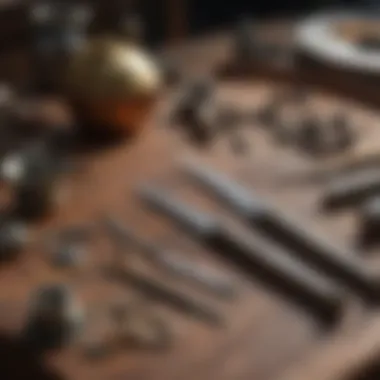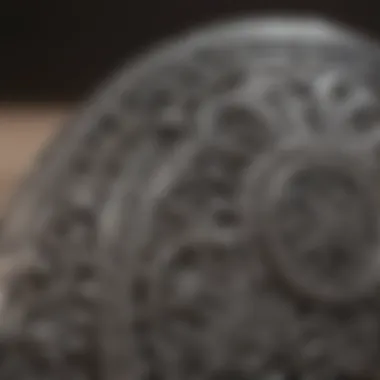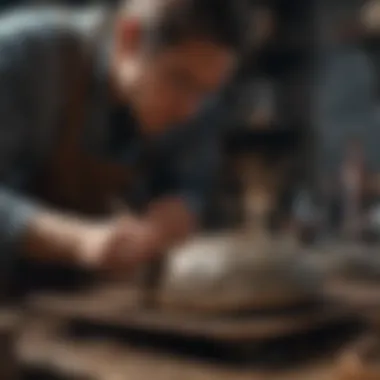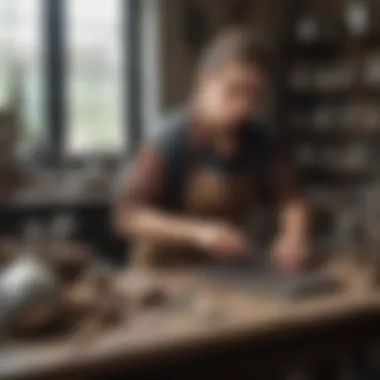Unlocking the Art of Metalwork: Explore Silversmith Classes Online


Rock and Fossil Identification
Delving into the world of silversmithing classes online provides a journey into the craftsmanship of creating intricate silver pieces. Before mastering metalwork, understanding the basics is essential. Silver is a noble metal known for its malleability and conductivity, making it a popular choice for jewelry and decorative items. Identifying different types of silver and understanding its characteristics is crucial in silversmithing.
In rock and fossil identification, enthusiasts must seek specific attributes such as color, luster, and crystal structure in silver ores. Distinguishing between various types of silver alloys is fundamental for creating high-quality pieces. The tools required for silver identification include magnifying glasses, scales for weight measurement, and chemical tests to determine silver purity.
Collecting Tips and Techniques
Navigating through silversmithing classes online involves not only technical knowledge but also practical skills in collecting materials. Aspiring silversmiths must understand the best practices for sourcing silver and other metals essential for crafting. Locating reputable suppliers and assessing the quality of raw materials is crucial for creating exceptional silver pieces.
Finding prime collecting sites for silver mining can enhance the authenticity and uniqueness of the metal used in silversmithing. Exploring mining regions, understanding geological formations, and networking with local miners can provide valuable insights for procuring silver for crafting purposes. Safely extracting silver from mines requires expertise in mining techniques and adherence to safety protocols to prevent accidents.
Preservation and Display
Preserving silver items and displaying them elegantly play a significant role in the art of silversmithing. Techniques for preventing tarnishing and deterioration of silver pieces involve protective coatings and proper storage methods. Utilizing anti-tarnish cloths, silica gel packets, and airtight containers can maintain the quality of silver creations.
Creative display ideas allow silversmiths to showcase their work in a visually appealing manner, attracting admirers and potential buyers. Decorative stands, shadow boxes, and themed presentations can enhance the aesthetic appeal of silver pieces, making them more alluring to collectors and enthusiasts.
Geological Insights
Understanding the geological aspects of silver mining and metalwork adds a layer of depth to the art of silversmithing. Geological formations where silver deposits are found offer valuable insights into the history of silver extraction. Exploring the chemical composition of silver ores and the geological processes involved in their formation enriches the silversmith's knowledge base.
The historical significance of silver in various civilizations throughout the ages highlights its enduring popularity and cultural value. Notable discoveries in silver mining history and extraordinary silver artifacts shed light on the artistry and craftsmanship involved in creating intricate silver pieces. Learning about famous silver mines and legendary silver artisans can inspire aspiring silversmiths to elevate their craft to new heights.
Introduction to Silversmithing
In this segment of the article, we delve into the fundamental aspects of silversmithing, setting the stage for a comprehensive exploration of online classes dedicated to mastering the art of metalwork. Silversmithing, a time-honored craft rooted in precision and creativity, offers enthusiasts a unique opportunity to create intricate silver pieces with a blend of tradition and innovation. By understanding the foundational principles of silversmithing, aspiring artisans can grasp the significance of this art form and the skill required to excel in it.
Understanding the Art of Silversmithing
History and Evolution of Silversmithing
The history and evolution of silversmithing unveil a rich tapestry of cultural heritage and craftsmanship, tracing back centuries to the skilled artisans who crafted awe-inspiring silver pieces. From ancient civilizations to modern-day design trends, the evolution of silversmithing showcases a seamless blend of tradition and contemporary aesthetics. Exploring the historical context of silversmithing not only invokes a sense of nostalgia but also offers valuable insights into the techniques and styles that have shaped this art form over time.
Significance of Silver as a Metal


Silver, hailed for its radiant beauty and malleability, holds a unique significance in the realm of metalworking. Its lustrous appearance and versatility make it a prized medium for creating exquisite jewelry and decorative pieces that stand the test of time. Understanding the inherent qualities of silver as a metal allows silversmiths to leverage its properties to bring their creative visions to life, showcasing the enduring allure of this precious material.
Role of Modern Technology in Silversmithing
The integration of modern technology has revolutionized the landscape of silversmithing, offering artisans innovative tools and techniques to augment their craft. From advanced equipment for metal fabrication to computer-aided design software for intricate detailing, technology plays a pivotal role in shaping the future of silversmithing. Embracing modern advancements empowers silversmiths to push the boundaries of traditional methods, unlocking new possibilities for artistic expression and craftsmanship.
Exploring Online Silversmithing Courses
Online silversmithing courses offer a gateway into the intricate world of metalwork, providing enthusiasts with a unique opportunity to enhance their skills from the comfort of their own homes. Understanding the importance of online silversmithing courses is crucial for individuals seeking to master the art of creating exquisite silver pieces. Exploring the digital realm for silversmithing education unveils a plethora of benefits, ranging from flexibility in learning schedules to access to expert instructors who elevate one's craftsmanship to new heights. Additionally, online courses often present cost-effective learning opportunities, making them an attractive choice for silver enthusiasts looking to delve into the world of silversmithing.
Popular Platforms for Silversmithing Classes
Skillshare
Skillshare stands out in the realm of online education for its user-friendly interface and diverse range of silversmithing courses. As a hub for creativity and skill development, Skillshare offers a wide array of classes tailored to cater to varying skill levels, making it an inclusive choice for beginners and advanced learners alike. The platform's interactive nature allows students to engage with instructors and fellow learners, fostering a collaborative learning environment that enhances the overall silversmithing experience. While Skillshare's broad selection of courses is a definite advantage, some may find that the platform lacks advanced courses in specific silversmithing techniques, posing a potential limitation for those seeking highly specialized instruction.
Udemy
Udemy serves as a treasure trove of silversmithing courses, providing learners with in-depth knowledge and practical skills essential for mastering the craft. With a focus on comprehensive curriculum design, Udemy's courses offer a structured approach to learning, guiding students from basic techniques to advanced metalwork projects seamlessly. The platform's emphasis on hands-on practice ensures that learners receive a well-rounded education in silversmithing. However, Udemy's vast course catalog can be overwhelming for beginners, who may struggle to navigate through the abundance of options available, requiring careful selection to find courses that align with their learning objectives.
Master
Class MasterClass sets itself apart by offering a unique learning experience through access to industry experts and renowned personalities in the field of silversmithing. By providing exclusive insights and specialized techniques from master artisans, MasterClass equips learners with the knowledge and skills needed to excel in silver jewelry design and metalwork. The platform's high production values and immersive video lessons create an engaging learning environment that mirrors a one-on-one mentorship experience, enriching the educational journey for students. Despite its prestige and expert-led courses, MasterClass's premium pricing may deter some individuals seeking more affordable silversmithing education options, posing a potential drawback for budget-conscious learners.
Practical Applications of Online Silversmithing
The section on practical applications of online silversmithing holds immense relevance in this article as it provides insights into how learners can apply their skills acquired from online classes in real-world settings. By delving into practical applications, enthusiasts can transition theoretical knowledge into tangible creations, thereby strengthening their understanding of silversmithing techniques.
Creating Personalized Silver Jewelry
Customizing Rings, Bracelets, and Necklaces:
In the realm of silversmithing, customizing rings, bracelets, and necklaces is a pivotal aspect that allows artisans to imbue their creations with a personal touch. This customization not only enhances the aesthetic value of the jewelry but also adds emotional significance for both the creator and the wearer. The versatility of customizing silver pieces provides learners with the opportunity to hone their craftsmanship skills by experimenting with different designs, sizes, and styles, ultimately perfecting their artistry.
Incorporating Gemstones into Silver Designs:
The incorporation of gemstones into silver designs elevates the aesthetic appeal of the jewelry pieces, creating a fusion of elegance and sophistication. By integrating gemstones such as diamonds, sapphires, or emeralds into silver settings, artisans can craft exquisite and unique pieces that resonate with individuals seeking luxurious and bespoke jewelry. This fusion of silver and gemstones showcases the artisan's skill in combining different materials to produce stunning and eye-catching jewelry.


Developing Unique Artistic Expressions:
Exploring and developing unique artistic expressions in silver jewelry design allows artisans to break away from traditional styles and unleash their creativity. By experimenting with unconventional shapes, textures, and forms, silversmiths can push boundaries and create avant-garde pieces that stand out in the competitive jewelry market. Embracing uniqueness and originality in design not only sets the artisan apart but also establishes a signature style that can attract a discerning clientele.
Crafting Functional Silver Objects
Designing Silver Utensils and Tableware:
Designing silver utensils and tableware is a practical application of silversmithing that combines functionality with aesthetics. The creation of silverware for daily use infuses artistry into everyday items, transforming them into pieces of functional art that elevate dining experiences. From designing intricate silverware patterns to crafting durable tableware, this aspect of silversmithing allows artisans to showcase their skill in merging form and function seamlessly.
Making Silver Decorative Items:
Crafting decorative items from silver encompasses a broad spectrum of artistic possibilities, ranging from ornate sculptures to intricate home décor pieces. The process of making silver decorative items involves intricate craftsmanship and attention to detail, resulting in visually striking creations that serve as focal points in interior design. Silver decorative items not only showcase the artisan's technical proficiency but also offer a medium for creative expression and artistic exploration.
Exploring Silver Sculpture Techniques:
Exploring silver sculpture techniques opens avenues for silversmiths to engage in three-dimensional artistry, allowing them to sculpt silver into captivating forms and structures. Sculpting silver enables artisans to unleash their creativity by shaping the metal into fluid and dynamic designs, thereby evolving traditional silversmithing into a form of contemporary sculptural art. This exploration of sculptural techniques fosters innovation and experimentation, leading to the creation of unique silver sculptures that blur the line between craftsmanship and art.
Exploring Silver Restoration and Repair
Understanding Silver Maintenance Practices:
Understanding silver maintenance practices is essential for silversmiths and collectors alike to preserve the longevity and quality of silver artifacts. Implementing proper maintenance routines, such as cleaning, polishing, and storage techniques, ensures that silver pieces retain their luster and value over time. By comprehending the nuances of silver care, artisans can educate clients on best practices for maintaining their silver jewelry, tableware, and decorative items.
Restoring Antique Silver Pieces:
The restoration of antique silver pieces requires a blend of expertise, precision, and historical knowledge to revive and preserve these revered artifacts. Restoring antique silver entails delicate processes such as cleaning off tarnish, repairing damage, and maintaining the authenticity of the piece's design and craftsmanship. By engaging in the restoration of antique silver, silversmiths can breathe new life into cherished heirlooms and cultural treasures, contributing to the preservation of heritage and craftsmanship.
Repairing Damaged Silver Artifacts:
Repairing damaged silver artifacts demands a keen eye for detail, a steady hand, and proficiency in soldering and metalwork techniques. Whether addressing scratches, dents, or structural issues, the process of repairing damaged silver artifacts requires careful assessment and skillful execution to ensure seamless restoration. By mastering the art of silver repair, artisans can salvage valuable silver pieces, reviving their beauty and utility for future generations to appreciate.
Mastering the Art of Silversmithing
In this pivotal section of our exploration into silversmithing, we delve deep into the essence of mastering the art form. Understanding the intricate techniques and refined skills necessary to excel in silversmithing is paramount in this comprehensive guide. Aspiring silversmiths will uncover the nuances of advanced metalwork processes, guiding them towards elevating their craftsmanship to new heights.
Mastering the art of silversmithing is a transformative journey that involves honing one's skills through diligent practice and a deep understanding of the craft's principles. By focusing on mastering soldering and joining methods, designers and artisans can create seamless silver pieces that exude excellence. Designing and fabricating intricate silver jewelry showcase the pinnacle of skill development, highlighting the technical prowess required in professional silversmithing. Additionally, refining finishing techniques is crucial in adding the final touches that elevate a silver creation to a masterpiece.


Enhancing one's expertise in filigree and granulation involves mastering the intricate art of delicate wirework and precise granule placement. This mastery enables silversmiths to create intricately detailed pieces with a timeless appeal, showcasing the remarkable intricacies of the art form. Chasing and repousse techniques contribute to the creation of three-dimensional designs on silver surfaces, adding depth and dimension to silver artworks. Exploring enameling and inlay work allows artisans to seamlessly incorporate vibrant colors and intricate patterns into their silver creations, adding a unique aesthetic dimension to their work.
Advanced Techniques and Specializations
Filigree and Granulation
Filigree and granulation represent the pinnacle of intricate and detailed work in the field of silversmithing. These techniques involve the delicate manipulation of silver wire and granules to create elaborate designs with a fine, lacy appearance. The key characteristic of filigree and granulation lies in the meticulous attention to detail and precision required to execute these designs flawlessly. Artisans embrace filigree and granulation for their ability to add a touch of elegance and sophistication to silver pieces, elevating them to exquisite works of art.
Chasing and Repoussé
Chasing and repoussé techniques are revered for their ability to add texture, dimension, and intricate patterns to silver surfaces. By skillfully manipulating the metal from both the front and back, artisans can create intricate designs that appear to come alive with movement and depth. The key characteristic of chasing and repoussé lies in the dynamic nature of these techniques, allowing designers to sculpt and shape silver in ways that traditional methods cannot match. While the advantages of chasing and repoussé include the ability to create visually stunning pieces, the main challenge lies in the precision and expertise required to execute these techniques successfully.
Enameling and Inlay Work
Enameling and inlay work bring a vibrant and colorful dimension to the world of silversmithing. These techniques involve the application of enamel (glass powder) or inlaid materials onto silver surfaces to create intricate designs and intricate patterns. The key characteristic of enameling and inlay work is the ability to infuse silver pieces with striking colors and visual textures, transforming them into unique and eye-catching works of art. While the advantages of these techniques include the added visual appeal and design versatility they offer, artisans must carefully consider the compatibility of different materials and the techniques required to achieve desired results in their silver creations.
Exploring Experimental Silverwork
Mixing Silver with Other Metals
Mixing silver with other metals opens up a realm of creative possibilities for silversmiths. This practice allows artisans to combine different metals such as gold, copper, or brass with silver to create unique alloys that possess varying properties and visual aesthetics. The key characteristic of mixing silver with other metals is the versatility it offers in terms of color, hardness, and malleability, enabling artisans to experiment with diverse materials to achieve their desired artistic vision. While the advantages of this practice include the creation of bespoke pieces with distinct visual and structural qualities, artisans must carefully consider the compatibility of metals and the techniques required to effectively fuse them together in their silverwork.
Incorporating Unconventional Materials
Incorporating unconventional materials into silverwork challenges traditional norms and pushes the boundaries of artistic expression. Artisans may choose to explore materials such as wood, ceramics, or even organic elements to infuse their silver creations with a unique and unexpected twist. The key characteristic of incorporating unconventional materials is the element of surprise and innovation it brings to silver artwork, allowing designers to create pieces that challenge conventional perceptions of the art form. While the advantages of this approach include the creation of truly one-of-a-kind pieces with a distinct artistic flair, artisans must carefully consider the structural integrity and long-term preservation of their creations when using unconventional materials.
Pushing Boundaries in Silver Artistry
Pushing boundaries in silver artistry involves breaking free from traditional constraints and exploring new realms of creativity and design. This approach encourages silversmiths to experiment with unconventional techniques, forms, and concepts to create avant-garde pieces that redefine the boundaries of traditional silversmithing. The key characteristic of pushing boundaries in silver artistry is the spirit of innovation and risk-taking it embodies, inspiring artisans to pioneer new trends and challenge the status quo. While the advantages of this progressive approach include the creation of cutting-edge and provocative artworks that captivate audiences, artisans must tread carefully to ensure that artistic integrity and craftsmanship are not compromised in the pursuit of innovation.
Showcasing Your Silversmithing Portfolio
Building a Professional Online Presence
Building a professional online presence is essential for silversmiths looking to showcase their work and attract a wider audience. Establishing a cohesive online portfolio that highlights one's best creations, design process, and artistic journey can significantly enhance visibility and credibility within the silversmithing community. The key characteristic of building a professional online presence lies in the ability to curate a visually engaging and informative platform that effectively communicates one's unique style and artistic vision. This approach not only allows artisans to reach a broader audience but also establishes a professional identity that encourages potential clients, collaborators, and collectors to engage with their work.
Photographing and Presenting Silver Pieces
Photographing and presenting silver pieces effectively is crucial for creating visually compelling portfolios and promotional materials. High-quality imagery that captures the intricate details, textures, and reflective surfaces of silver artworks plays a significant role in conveying the craftsmanship and aesthetic appeal of the pieces. The key characteristic of photographing and presenting silver pieces lies in the ability to capture the essence and beauty of each creation through skillful composition, lighting, and editing. While the advantages of this practice include enhancing the visual impact and marketability of silver pieces, artisans must invest time and effort in mastering photography techniques to ensure that their work is represented accurately and professionally.
Marketing Your Silverwork Creations
Marketing your silverwork creations effectively is essential for expanding your reach and building a sustainable presence in the competitive silversmithing industry. Crafting a strategic marketing plan that leverages online platforms, social media channels, and networking opportunities can help silversmiths attract clients, collaborations, and opportunities for showcasing their work. The key characteristic of marketing your silverwork creations lies in the ability to communicate the value, uniqueness, and craftsmanship of your pieces to a diverse audience of potential buyers and enthusiasts. By positioning your brand effectively, sharing compelling stories behind your creations, and engaging with your audience authentically, you can cultivate a loyal following and drive interest in your silver artwork.







